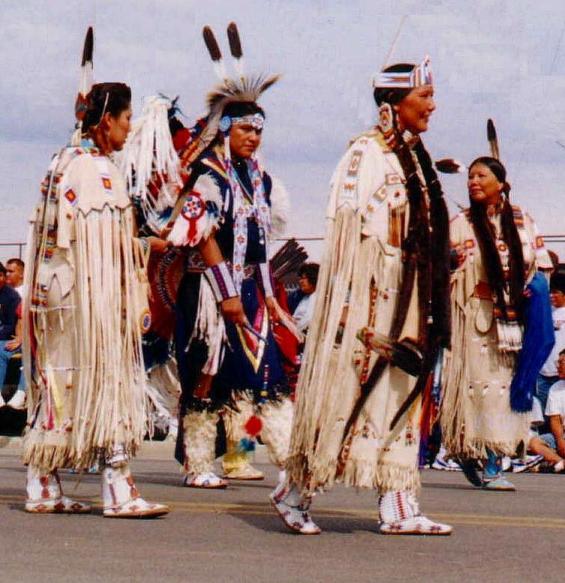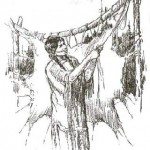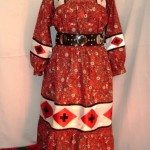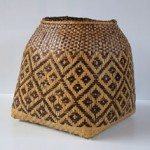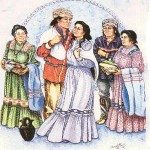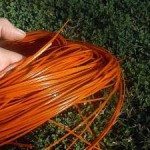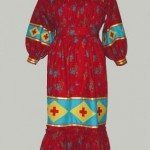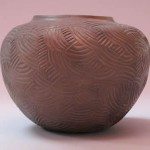Cherokee Culture Notes Edited
and Revised: August 27, 2000
Fact Sheet Author Unknown
Edited by: Wendell Cochran, Tahlequah, OK
Cherokee Clothing and Adornment
The earliest description of southeastern Indian costumes might apply to the Cherokee was written by Adair (p. 7 et seq.) who lived among the Cherokees from 1736 to 1744. He later lived with the Chickasaw, so it is not clear whether his description applied to the Cherokee, Chickasaw, or to southeastern Indians in general. Never the less, it is worthwhile considering that his writings give us a description of pre-White clothing.
Men’s Clothing Adair said that men generally wore shirts of dressed deer skins in summer; in winter they wore shirts of panther, bear, otter, beaver and buckskin (with the hair still on and turned to the inside.) When hunting, they wore thin buckskins boots reaching high upon the thighs so that the shirts lapped over them. These high top boots were sewn together about five inches from the edge along the length of the legs so that the edges could be cut into fringes. Fawn hoofs, wild turkey spurs and metal trinkets were fastened to the fringes. They wore breech clouts, about 40 inches wide and 60 inches long. He said that the men had a great aversion to wearing breeches, which they considered effeminate. Timberlake said that Cherokee men wore breech clouts, cloth boots, moccasins and a large mantle (cape, ed.) By 1762, he said, the clothing had become much like the Europeans.
The Payne Manuscripts contain a description of men’s clothing. The general costume for men included a leather shirt that came down to the hips and had sleeves. The breech clout of deerskin was wide enough so that after it had been drawn up between the legs and held by a girdle, the back and front flaps were fastened together at the sides. Full-length skin mantles were worn fastened at the left shoulder and were often belted at the waist. Sometimes these mantles were made of feathers. Moccasins were made like half boots, extending half way up the leg. They had small bells fastened to them around the ankles. Prominent warriors wore bands of otter skin on their heads, upper arms, and on their legs just below the knees. Payne also describes the use of breastplates, helmets ornamented with red feathers and bowstring guards for the left arm, all made from buffalo hide.
The Peace Chief’s robes were quite elaborate. When he was first installed, the entire costume was dyed yellow otherwise it was entirely white. It consisted of: A shirt of white feathers that came to the hips; a white leather breech clout fastened at the sides; a white leather belt that went twice around the body and had tassels that hung down to the knees; white leather leggings, garters, and moccasins with small bells attached; a long cloak fastened at both shoulders with “curiously wrought pins”; a cap made of otter skin with white leather band and white crane feathers fastened to it from the crown of the cap down to the band, giving it a perfectly white appearance.
In an additional set of notes by DeBrahms (pp. 223-224) it is stated that separate sleeves made from raccoon skins were slipped on the Chief’s arms, strings of deer hooves were fastened around his ankles, a white leather tobacco pouch was carried in his left hand, and he carried a white swan’s (crane, ed.) wing in his right hand. He also describes a headdress made of raccoon skins dyed yellow and gramosin (red?, ed.) that had two long ends hanging down the back. (This resembles the crown worn by Tanasi who was taken to England by Sir Alexander Cumming in 1730. ed.) DeBrahms was present at the installation of the Chief of Estoge, about 1756. At a later period, Bartram (pp. 393-395) offers this description of men’s clothing. The breech clout of the ancient period was still being worn, but it was made of blue cloth (wool broadcloth Stroud? Ed.) and was about eighteen inches wide. The ends were ornamented with beads, tinsel, lace, etc. He said cloth boots, reaching from ankle to calf (leggings? ed.), were ornamented with beads, lace, silver bells, etc. Soft deerskin moccasins, ornamented according to individual fancy were worn. (Timberlake said that moccasins were decorated with porcupine quill work.) Mantles, either scarlet or blue and decorated with lace, fringe, silver or brass bells, were worn over the shoulder. Short feather cloaks, made from brilliantly colored feathers, were also worn over the shoulders. Sometimes, ruffled shirts of fine linen were worn, belted or hanging loose. The men at Cowee (p. 299) wore high waving plumes.
Women’s Clothing Cherokee women wore a wrap-around skirts of skin, either dressed deerskin or small skins sewn together; the skirt reached a little below the knees. In winter, they wrapped themselves in buffalo calfskin with the hair worn inside. Both young women and men wore a six-foot square of cloth with a wide border; it was worn like a Roman toga. Later, as trade goods became more common, women wore a wrap-around skirt of scarlet Stroud cloth (wool broadcloth. Ed.) covered with brass runners or buckles, and fastened with a leather belt.
The earliest description of southeastern Indian clothing comes from the DeSoto narratives (Ranjel in Bourne, Vol. II. pp. 87-88). Although they refer to the Muskhogean tribes, it is very likely that most of the southern woodland Indians wore similar garments. Women wore two kinds of garments, one from the waist down like a short skirt, the other over the upper part draped over the left shoulder leaving the right arm uncovered. They wore woven materials made from thread coming from the inner bark of the mulberry tree.
The Payne Manuscripts describes the women’s skirts among the ancient Cherokees as resembling those described earlier by the Spaniards. The materials for the skirts in this case were woven from strips of inner bark from the roots of the mulberry tree. The strips varied from 1/8 to 1/2 inch wide and were woven like a basket weave, probably a simple over and under technique. The color was either yellow or red, or possibly a combination of the two colors.
The skirts were described as very pliable, so the strips must have been thin and soft. Wild hemp was also used in weaving these skirts, which were often trimmed with fringe of feathers. The women also wore short gowns (probably capes. Ed.) made from turkey feathers.
The feathers, an inch to an inch and a half long, were sewn between two strips of mulberry bark, using bark thread. Although the technique was not described, they must have used some sort of netting as a foundation to which the feathers were sewn, or perhaps even twined into. The feather strips overlapped so none of the foundation could be seen.
Bartram, in his later descriptions, says that the women wore longer skirts, to about the middle of the lower legs, and a little short waistcoat made of calico, cloth decorated with lace, beads, etc. At Cowee, he saw girls dressed in white robes wearing beads, bracelets and a “profusion of gay ribbands” (p. 498).
Hair Styles The only early description of how hair was worn is by Timberlake who said (p. 75) that the men shaved it off or plucked it out except for a patch on the crown of the head about twice the size of a British crown piece. This patch was ornamented with beads, feathers, wampum, stained deer hair, etc. Women wore their hair long (pp. 76-77) and clubbed up with ribbons of various colors.
Ornaments and Trade Goods The following information was provided by the University of Tennessee collections of objects found in Cherokee burial sites of the historic period (Post-European contact. Ed.). Most of the objects were ornaments, but some inferences about costumes may be drawn.
Excavations at Chote, the principal peace town of the Overhill group, unearthed the following items. Burial site of a three year old child: six small conical brass buttons with raised crests found at the neck, apparently strung on a cord with five medium sized glass beads to make a necklace. A plain brass buckle at the back of the head may have been used to fasten the hair. Forty conical brass ornaments were apparently fastened to leggings; a large Morris bell was near the right foot; and a carved brass wire bracelet, probably was on an arm. An adult man had two small brass buttons at the left side and some glass beads at the right: the buttons may have fastened a belt, and the beads may have ornamented a pouch. Buttons and bracelets were evidently common.
At Ocoee, another excavation site, additional examples of these items were found. Other items found include: Glass beads used as ornamentation on belts, pouches, breech clouts and shoulder bands. In two graves, tubular brass ornaments had been made into shoulder bands. Small cut out animal effigies were worn as necklaces. Glass beads were sewn on garters worn by women. Cast brass Morris bells were fastened to arms, legs or shirts. One child had eleven German silver buttons that were probably sewn to a coat. There were several examples of larger-sized glass beads worn as necklaces, as well as numberous small beads that had been used to ornament clothing, etc.
Many different kinds of brass objects made from brass kettles were found. There were also brass objects such as brass disks, bells, buttons and bracelets that had been made by European or Colonial manufacturers, but these were rarer than those made by the Cherokees.
Objects from brass kettles included: Disks with center holes worn on vest; Collars varying from one half inch to three inches wide; Arm bands for upper an d lower arms varying from one half inch to six inches wide; Conical Jinglers fastened to clothing; Tubes woven into shoulder bands; Earbobs, triangular and rectangular in shape; Finger rings; Bands for braids; and Animal effigy pendants. Silver objects, usually of European or Colonial manufacture, included: Kidney-shaped gorgets; circular gorgets (medallions. Ed.); bracelets; Earbobs; Buckles; and German silver buttons.
One example of a native-made silver object was found – a triangular earbob. Small brooches, like those of the Iroquois type, were worn, but were rare. It is noted historically that Sequoyah made many silver bracelets and other ornaments, according to his cousin Major George Lowery.
Iron was used, but less common, usually represented by wire bracelets or in combination with brass strips. Trade goods were distributed by white government officials as gifts to the Cherokees and other Southeastern tribes. Between 1753 and 1757, William Little, an Indian agent, list distribution of the following trade items, clothing and ornaments (Georgia History Quarterly, Vol. XIII, p. 138. fn.): 640 pieces of gartering, 616 pieces of caddis (a type of worsted ribbon or binding for garters), 163 yards of embroidered serge; 175 yards of blue Stroud cloth; 9 pieces of striped duffel; and 128 yards of calico. All of these were woven fabrics to be used for clothing.
Ready made articles of clothing included: 34 hats; 32 coats; 6 laced waistcoats; 88 garlix shirts; 141 checkered shirts; and 110 blankets. He also distributed: 575 hawk bells (small bells used by Falconers? Ed.); 27 pounds of brass wire; 40 ivory combs; 72 horn combs; and 106 looking glasses.
The Cherokees also purchased these same types of objects from traders. Cherokee words for various kinds of clothing are: Agwanu’ – clothing, Asa’ni – woman’s dress, Ka’na-gasu-lanu – Hunting shirt, Gato’la yatu-sulo’ – Breech clout
We thank our friends at MyBookie.ag for supporting our website! For the latest MyBookie promotion codes, click here. Find more promo codes at BonusPromoCode.com.

